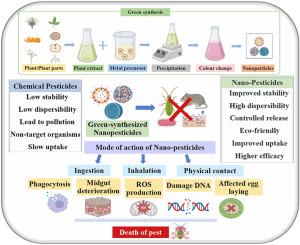纳米农药在植物保护中的应用:潜力、机理和对植物病原体和害虫的未来展望
IF 3.3
3区 农林科学
Q2 PLANT SCIENCES
引用次数: 0
摘要
大多数农药是化学生产的,这可能会产生不可预见的后果,如过度消耗能源、污染以及对环境和人类健康的风险。植物正在成为一种可行的、更可持续的大规模生物合成纳米农药的来源。在快速稳定的单步绿色合成过程中,金属离子可以利用植物成分被生物还原成纳米粒子。纳米农药更容易获得,成本更低,造成的污染更少,同时也改善了环境和人类安全。如今,纳米农药可用于控制各种植物害虫,包括细菌、真菌和昆虫。纳米农药的作用机制影响表皮的完整性和颜色,引发免疫反应,改变内部基因表达,诱导细胞毒性,损害昆虫的生长和繁殖。由于活性氧的释放及其代谢活动的变化,昆虫受到损害。纳米粒子可以破坏植物病原体的细胞壁和细胞膜,阻止孢子萌发,干扰细菌复制。因此,它们的影响不仅仅局限于昆虫,它们在控制害虫和疾病的方法中发挥着重要作用。这篇文章涵盖了各个领域的研究,包括植物病原体和害虫控制、植物源性农药和纳米农药。在作物系统有害生物治理方面,本文综述了植物基农药、绿色合成纳米农药、创新的有害生物治理策略、植物与有害生物相互作用、纳米农药的作用机制及其局限性等方面的研究进展。它强调了将现有文献和正在进行的研究计划联系起来的能力,具有广泛的应用,用于验证植物提取物在病虫害管理中的使用,以及开发基于植物的纳米农药,这些农药对环境来说是成功的、安全的、可持续的,并且被广泛使用。本文章由计算机程序翻译,如有差异,请以英文原文为准。

Nanopesticides in plant protection: Potentials, mechanistic insights, and future perspectives against phytopathogens and insect pests
The majority of pesticides are produced chemically, which might have unforeseen consequences such as excessive energy consumption, pollution, and risks to the environment and human health. Plants are emerging to be a viable, more sustainable source for the biosynthesis of nano-pesticides on a large scale. In a quick and stable single-step green synthesis process, metal ions can be bio-reduced into nanoparticles (NPs) using phytoconstituents. Nano-pesticides are more accessible, less costly, and cause less pollution while also improving environmental and human safety. Nowadays, nano-pesticides can be used to control a variety of plant pests, including bacteria, fungi, and insects. The mechanism of action of nano-pesticides affects the integrity and coloration of the cuticle, triggers immunological reactions, alters gene expression internally, and induces cellular toxicity that impairs the insect's growth and reproduction. Due to the release of reactive oxygen species and the change in their metabolic activity, insects are rendered impaired. Nanoparticles can break down the cell wall and membrane of phytopathogens, prevent spores from germinating, and interfere with bacterial replication. So, their effects go beyond only insects, and they play a big role in methods for managing both pests and diseases. This article spans research from various fields, including phytopathogens and insect pest control, plant-derived pesticides, and nano-pesticides. In terms of pest management in crop systems, this review acts as a thorough compilation, covering topics such as plant-based pesticides, green-synthesized nano-pesticides, innovative pest management strategies, NP-pest interactions, mechanisms of action of nano-pesticides, and their limitations. It highlights the ability to connect the dots between existing literature and ongoing research initiatives, with a wide range of applications for validating the use of plant extracts for pest management and developing plant-based nano-pesticides that are successful, secure, and sustainable for the environment, and widely utilized.
求助全文
通过发布文献求助,成功后即可免费获取论文全文。
去求助
来源期刊
CiteScore
4.30
自引率
7.40%
发文量
130
审稿时长
38 days
期刊介绍:
Physiological and Molecular Plant Pathology provides an International forum for original research papers, reviews, and commentaries on all aspects of the molecular biology, biochemistry, physiology, histology and cytology, genetics and evolution of plant-microbe interactions.
Papers on all kinds of infective pathogen, including viruses, prokaryotes, fungi, and nematodes, as well as mutualistic organisms such as Rhizobium and mycorrhyzal fungi, are acceptable as long as they have a bearing on the interaction between pathogen and plant.

 求助内容:
求助内容: 应助结果提醒方式:
应助结果提醒方式:


